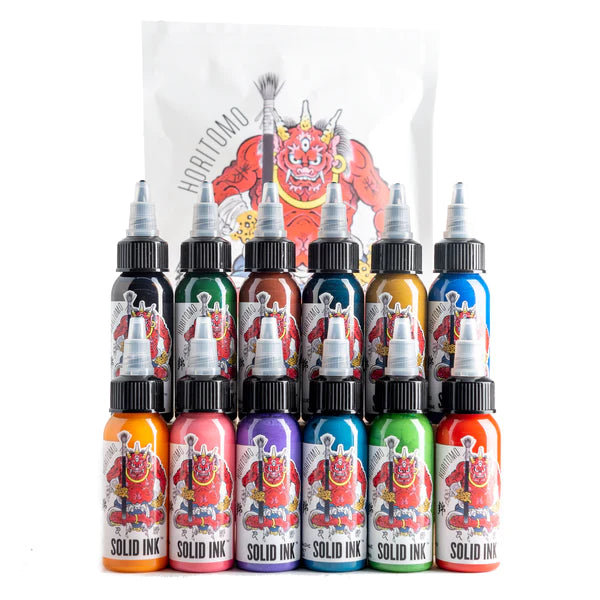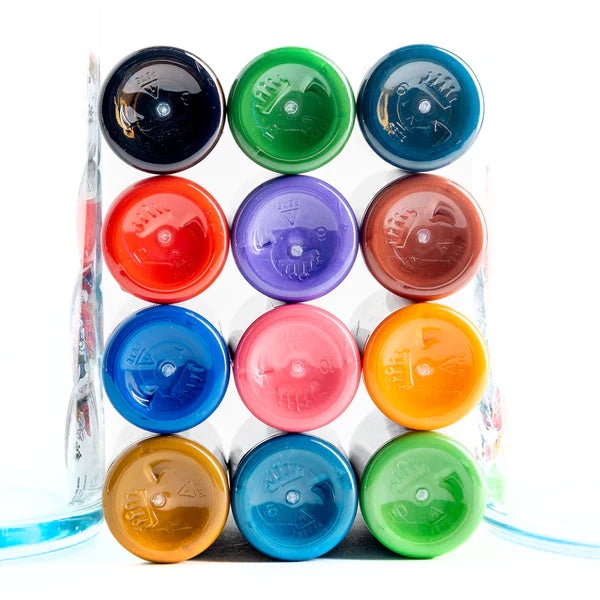1
/
of
3
Solid Tattoo Ink - Horitomo Color Set (1 oz)
- Regular price
-
$140.00 - Regular price
-
- Sale price
-
$140.00
Shipping calculated at checkout.
Couldn't load pickup availability
These tones were developed and tested by Master Horitomo, with his experience in traditional Japanese tattooing, we were able to achieve the colors for a perfect Japanese tattoo composition.
Set Includes:
- Fudo Blue Black
- Fudo Blue Grey
- Moegi
- Kikya
- Odo
- Wakanae
- Shu
- Gunjo
- Sakura
- Koji
- Bengara
- Shinbashi
Odo This color is a yellowish brown ochre tone reminiscent of straw and the materials related to woodwork. I would also use these for the clothing of Fujin and Raijin. I like using it when I want a subtle color tone.
Moegi This is a color that has been used in Japan since the Heian Period (794-1192). In Kabuki Theatre, this is one of the three colors of the final closing curtain. It is a reserved and subtle green. I find it suitable for the base color of dragons, Fujin, oni, the kimono of samurai, as well as the leaves of kiku (chrysanthemum) and botan (peony).
Wakanae This light subtle green is based on the color of young sprouted rice. It is suitable for Buddhist pieces, kimono patterns and the underside of leaves.
Koji This reddish yellow is connected to Buddhism in Japan. I think it is a nice base color for tigers as well as for metal pieces of samurai armor. This goes well with a bright yellow to give an old world ukiyo-e irezumi feel.
Kikyo This color is derived from the flower of the same name, Kikyo, and has been used since the Heian Era (794-1192). This bluish purple is very dignified and is suitable for the kimonos of samurai and oiran.
Bengara This reddish brown color was popularized during the Edo Period (1603-1867). In Japanese irezumi this color has been used for a very long time, since the days when colors were very limited. By using Bengara, Shu and my Sumi Set, you can invoke a very "old world" look and feel.
Shu This color exists between red and orange and is a classic color of Japan. In Japanese irezumi this color has been used for a very long time, since the days when colors were very limited. By using Shu, Bengara, and my Sumi Set, you can invoke a very "old world" look and feel.
Sakura This pink was created with the cherry blossom flower in mind. In old irezumi, Shu was used for these flowers, but this modern color is more true to the actual color of the iconic Japanese flower and has a softer feel. I also feel it is great for tennyo as well as for the eye shadow on woodblock print style women.
Shinbashi Towards the end of the Meiji Era (1868-1912) this color was popular amongst the geisha of the Shinbashi district in Tokyo. It is a reserved but still bright, blue tone. Aside for its obvious use for kimono color, I feel it works great for yurei (ghosts) and yokai (supernatural creatures).
Gunjo This color is a deeper blue, similar to a toned down ultramarine. This color has been associated with men's clothing for many years in Japan. I like using this for samurai clothing and armor.
Fudo Blue Black This color was based on the color of the body of Fudo Myo-o. In the Jyu-Kyu Kan text, the skin coloration of Fudo Myo-o is described as blue-black. While there are other colorations of Fudo Myo-o, this particular color is inspired by that text and I feel is a good, strong color for Fudo Myo-o.
Fudo Blue Grey This color is meant to be used with Fudo Blue Black. These two colors together can be used to create a powerful Fudo Myo-o. If you desire to create a bit lighter toned, brighter Fudo Myo-o, you can use Fudo Blue Grey as a base and fade it out with a 50-50 mix of Fudo Blue Grey and Solid White.
-
Hurry, only 1 item left in stock!



Solid Tattoo Ink - Horitomo Color Set (1 oz)
- Regular price
-
$140.00 - Regular price
-
- Sale price
-
$140.00
Guarantees
-
100% Customer
Satisfaction Guarantee -
Fast, Free Shipping!
-
Largest selection of
top quality products -
Free Gifts on
larger orders



